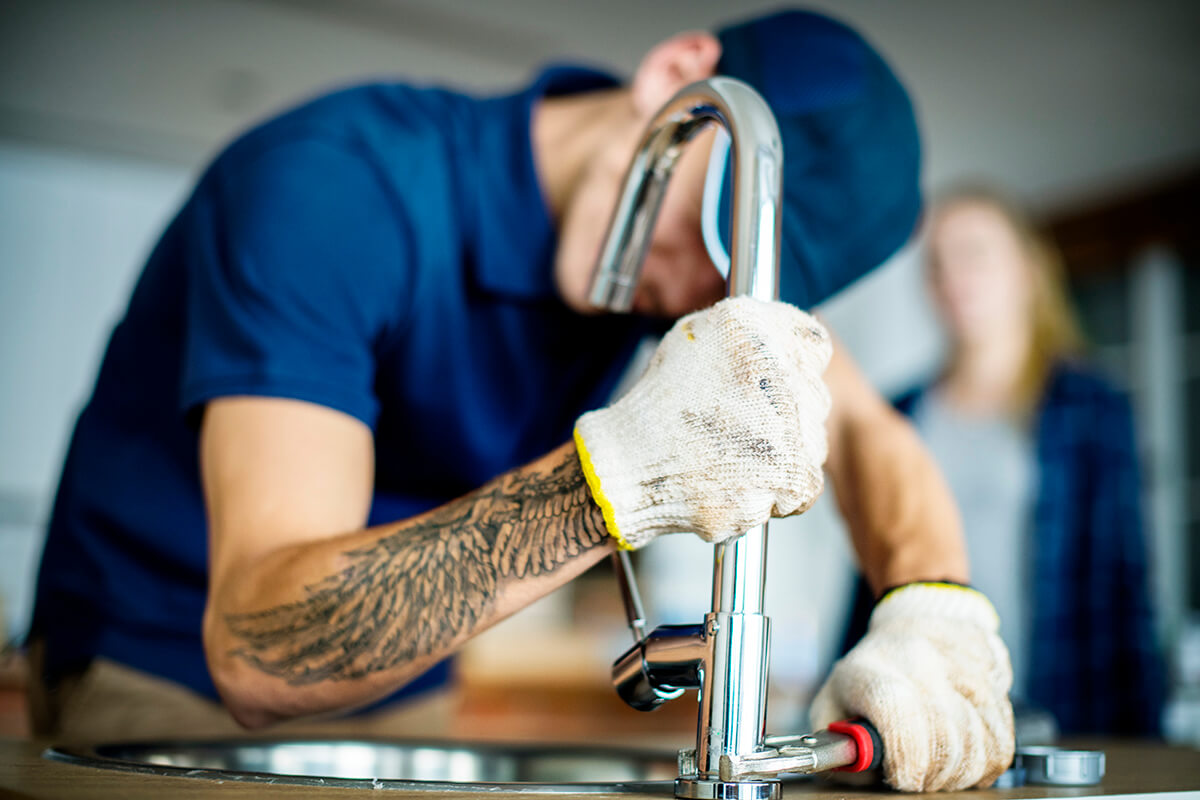If you notice a leak in your kitchen sink, it's important to address it as soon as possible. Not only can a leak cause damage to your cabinets and floors, but it can also waste a significant amount of water and increase your water bill. The first step in fixing a leaky kitchen sink is to locate the source of the leak. This can often be found by inspecting the pipes under the sink for any visible cracks or loose connections. Once you have identified the source of the leak, you can begin the repair process. In most cases, you will need to replace the affected pipe or seal it with plumber's tape. Make sure to turn off the water supply to the sink before starting any repairs. You may also want to place a bucket or towels underneath the sink to catch any water that may drip during the repair. After the repair is complete, turn the water supply back on and check for any remaining leaks. If the leak persists, it may be best to call a professional plumber for further assistance.1. How to Fix a Leaky Kitchen Sink Plumbing
Fixing kitchen sink plumbing issues can seem like a daunting task, but with the right tools and knowledge, it can be a simple DIY project. The first step is to gather all necessary tools and materials, including a pipe wrench, plumber's tape, and replacement pipes or fittings. Next, turn off the water supply to the sink and place a bucket or towels underneath to catch any water that may drip. Use the pipe wrench to loosen and remove the affected pipe or fitting. If the pipe is corroded or damaged, it will need to be replaced. Before installing the new pipe or fitting, make sure to clean the area and apply plumber's tape to the threads. This will help create a tight seal and prevent future leaks. Tighten the new pipe or fitting with the pipe wrench and turn the water supply back on to check for any leaks.2. DIY Guide for Fixing Kitchen Sink Plumbing
There are several common problems that can occur with kitchen sink plumbing, but they all have simple solutions. A leaky faucet, for example, can often be fixed by replacing the rubber gasket or O-ring inside the faucet handle. Clogged drains can be cleared with a plunger or plumbing snake. If you notice slow drainage in your sink, it may be due to a clogged air vent. This can be solved by cleaning the air vent with a plumbing snake or by calling a professional plumber. Another common issue is a garbage disposal that is not working properly. This can often be fixed by pressing the reset button on the bottom of the disposal unit.3. Common Problems and Solutions for Kitchen Sink Plumbing
Repairing kitchen sink plumbing may seem like a complicated task, but with a step-by-step guide, it can be a simple process. The first step is to gather all necessary tools and materials, including a pipe wrench, plumber's tape, and replacement pipes or fittings. Next, turn off the water supply to the sink and place a bucket or towels underneath to catch any water that may drip. Use the pipe wrench to loosen and remove the affected pipe or fitting. If the pipe is corroded or damaged, it will need to be replaced. Before installing the new pipe or fitting, make sure to clean the area and apply plumber's tape to the threads. This will help create a tight seal and prevent future leaks. Tighten the new pipe or fitting with the pipe wrench and turn the water supply back on to check for any leaks.4. Step-by-Step Guide for Repairing Kitchen Sink Plumbing
When it comes to troubleshooting kitchen sink plumbing issues, the first step is to identify the problem. This can often be done by inspecting the pipes and fittings under the sink for any visible damage or leaks. If the problem is not immediately apparent, you may need to use a plunger or plumbing snake to clear clogged drains. If the issue is with a garbage disposal, make sure the power is turned off before attempting to fix it. Pressing the reset button on the bottom of the disposal unit may solve the problem. If not, it may be best to call a professional plumber for further assistance.5. Troubleshooting Tips for Kitchen Sink Plumbing Issues
Having the right tools and materials is essential for fixing kitchen sink plumbing issues. Some of the most commonly needed tools include a pipe wrench, plunger, plumbing snake, and adjustable wrench. You may also need to have plumber's tape, replacement pipes or fittings, and a bucket or towels on hand. If you plan on fixing more complex plumbing issues, it may be beneficial to invest in a pipe cutter, pipe wrench set, and other specialized tools. These tools will not only make the job easier, but they can also save you money in the long run by preventing the need for professional assistance.6. Tools and Materials Needed for Fixing Kitchen Sink Plumbing
Deciding between hiring a professional plumber or attempting a DIY repair for kitchen sink plumbing issues can be a tough choice. While some repairs may be simple enough to do on your own, others may require specialized skills and equipment that only a professional plumber will have. If you are unsure about your ability to fix the issue, it may be best to call a professional. Attempting a repair without the proper knowledge and tools can lead to further damage and end up costing you more in the long run. However, if you have experience with plumbing repairs and feel confident in your abilities, a DIY fix may be the more cost-effective option.7. Professional vs DIY: Which is Better for Fixing Kitchen Sink Plumbing?
Clogged kitchen sinks are a common problem that can be frustrating to deal with. However, with a plumbing snake, you can easily clear the blockage and get your sink draining properly again. Start by inserting the snake into the drain and turning the handle to push it further into the pipe. Once you feel resistance, rotate the snake in a clockwise direction to break up the clog. Continue pushing and turning the snake until you feel the clog has been cleared. Then, run hot water down the drain to flush out any remaining debris. If the clog persists, you may need to call a professional plumber for further assistance.8. How to Unclog a Kitchen Sink with Plumbing Snake
The best way to avoid kitchen sink plumbing issues is to properly maintain your plumbing system. This includes regularly cleaning and inspecting the pipes and fittings under the sink, as well as being mindful of what you put down the drain. Avoid pouring grease, oils, and large food scraps down the sink, as these can cause clogs and damage to your pipes. Using a drain strainer can also help prevent debris from entering the pipes. Regularly using a plumbing snake to clear any minor clogs can also help prevent larger issues from arising.9. Preventing Future Problems with Kitchen Sink Plumbing Maintenance
If you are facing a kitchen sink plumbing issue that you are not equipped to handle on your own, it may be time to call a professional plumber. Before hiring a plumber, make sure to do your research and choose a reputable and experienced company.10. Hiring a Plumber for Fixing Kitchen Sink Plumbing: What to Know
Common Problems with Kitchen Sink Plumbing

Leaky Faucets and Pipes
 If you've noticed a constant dripping from your kitchen sink faucet, you may have a leaky faucet. This can not only be annoying but can also waste a significant amount of water and lead to higher water bills. The most common cause of a leaky faucet is a worn-out washer or O-ring. These can easily be replaced with a trip to the hardware store and some basic tools.
Another common issue with kitchen sink plumbing is leaky pipes. Over time, pipes can develop cracks or lose their seal, causing water to leak out. This not only wastes water but can also lead to water damage and mold growth. If you notice any water pooling under your sink or dripping from pipes, it's important to address the issue as soon as possible to prevent further damage.
If you've noticed a constant dripping from your kitchen sink faucet, you may have a leaky faucet. This can not only be annoying but can also waste a significant amount of water and lead to higher water bills. The most common cause of a leaky faucet is a worn-out washer or O-ring. These can easily be replaced with a trip to the hardware store and some basic tools.
Another common issue with kitchen sink plumbing is leaky pipes. Over time, pipes can develop cracks or lose their seal, causing water to leak out. This not only wastes water but can also lead to water damage and mold growth. If you notice any water pooling under your sink or dripping from pipes, it's important to address the issue as soon as possible to prevent further damage.
Clogged Drains
 Clogged drains are another frequent problem with kitchen sink plumbing. This can be caused by a buildup of food particles, grease, or other debris in the pipes. To prevent clogs, make sure to properly dispose of food scraps and avoid pouring grease down the drain. If you do experience a clog, try using a plunger or a drain snake to clear it. For tougher clogs, a professional plumber may be necessary.
Clogged drains are another frequent problem with kitchen sink plumbing. This can be caused by a buildup of food particles, grease, or other debris in the pipes. To prevent clogs, make sure to properly dispose of food scraps and avoid pouring grease down the drain. If you do experience a clog, try using a plunger or a drain snake to clear it. For tougher clogs, a professional plumber may be necessary.
Low Water Pressure
 If your kitchen sink's water pressure seems lower than usual, there could be a few different causes. One common issue is a clogged aerator, which can be easily cleaned or replaced. Another possible cause is a buildup of sediment in your pipes, which can be remedied by flushing them out. However, low water pressure can also be a sign of a more serious problem, such as a leak in the water line. If you're unable to determine the cause of low water pressure, it's best to call a professional plumber for assistance.
If your kitchen sink's water pressure seems lower than usual, there could be a few different causes. One common issue is a clogged aerator, which can be easily cleaned or replaced. Another possible cause is a buildup of sediment in your pipes, which can be remedied by flushing them out. However, low water pressure can also be a sign of a more serious problem, such as a leak in the water line. If you're unable to determine the cause of low water pressure, it's best to call a professional plumber for assistance.
Conclusion
 By addressing these common problems with kitchen sink plumbing, you can save yourself from potential headaches and costly repairs in the future. However, if you encounter any issues that you're unable to fix yourself, don't hesitate to reach out to a professional plumber. With proper maintenance and timely repairs, your kitchen sink plumbing can continue to function smoothly and efficiently for years to come.
By addressing these common problems with kitchen sink plumbing, you can save yourself from potential headaches and costly repairs in the future. However, if you encounter any issues that you're unable to fix yourself, don't hesitate to reach out to a professional plumber. With proper maintenance and timely repairs, your kitchen sink plumbing can continue to function smoothly and efficiently for years to come.
























:max_bytes(150000):strip_icc()/how-to-install-a-sink-drain-2718789-hero-24e898006ed94c9593a2a268b57989a3.jpg)
















/how-to-install-a-sink-drain-2718789-hero-24e898006ed94c9593a2a268b57989a3.jpg)























/how-to-unclog-a-kitchen-sink-2718799_sketch_FINAL-8c5caa805a69493ab22dfb537c72a1b7.png)






















